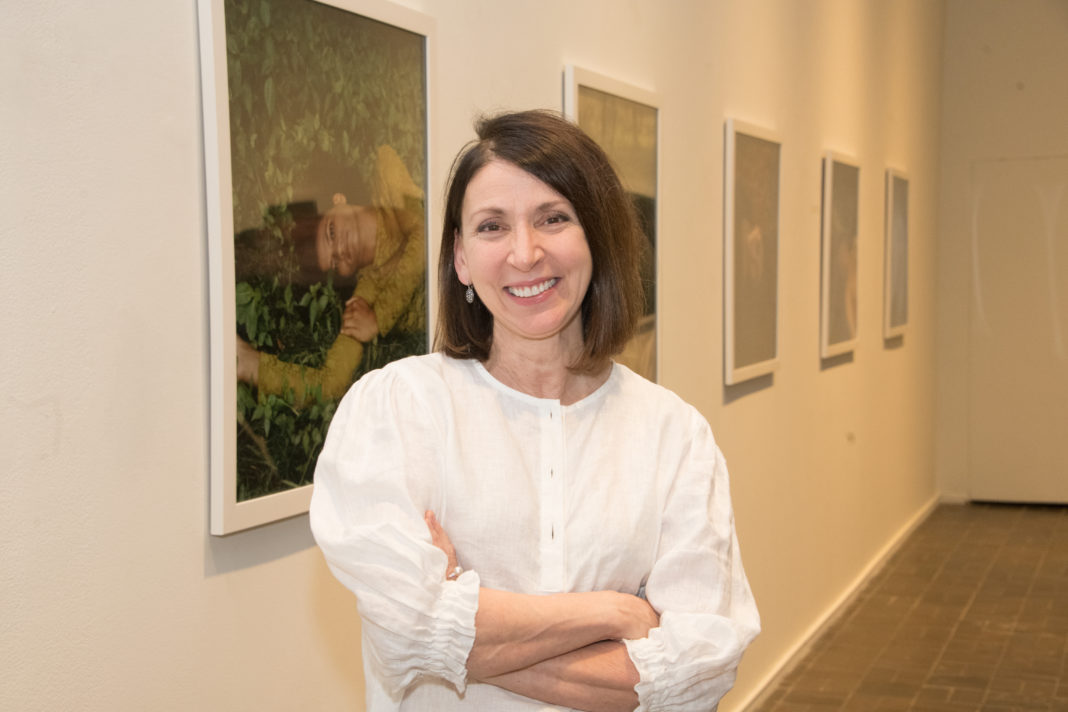A woman with a tube of lipstick stared out of the projection screen at the crowd in the recital hall. She began applying lipstick, using the camera like a mirror as she dragged the cosmetic from the corner of her mouth to the other, then up and around her top lip, then down and around her bottom lip. She continued, going around and around her mouth, as the coat around her lips grew thicker and thicker, the woman pushing hard into the flesh of her lip. The lipstick grew warm from the friction and crumbled into a clump on the side of the tube. She closed her eyes, pressed the clump between the tube and her lips once more, then opened them, daring the watcher to break eye contact.
Lydia Panas stopped the video at that point. “That’s enough for now.”
This was the second video clip Panas, a renowned photographer, a lecturer at Muhlenberg and one of the artists currently on display in Martin Art Gallery, shared with the audience at her talk on Wednesday, Mar. 27. Panas was born in the U.S. by chance, to Greecian immigrant doctors, and didn’t speak English until she was well past five. She believes this delay in language is how she learned to watch people so closely.
Panas took the audience on a tour of her diverse portfolio, which features a blend of portraits and still lifes on simple backgrounds. She draws inspiration from renaissance paintings and humans’ relationship to the natural world, and combines it with her own subconscious interests. Most of her images are captured outdoors in golden sunlight with a soft focus, or inside on a dark and heavy backdrop.
She began her career in photography capturing images on film of her own children in natural landscapes. One photo she showed featured a little girl, sevenish, sitting on a pile of smooth stones, wearing a few across her collarbone like a necklace. During this point in her life, said Panas. Panas found herself searching for the spirit of her deceased Greek father in the landscapes of Greece. This photo was taken on one of those beaches.
As her children grew older, Panas moved onto taking still lifes of chocolate, hair from her hairbrush and dryer lint, which represent aging and desire.
“These collections related to time passing, work around the house, fears and desires,” said Panas. “They were symbolic of what we discard and what we lose as a result. As markers of time, the images recall what falls away and what is gained.”
She then photographed portraits where individuals held food in their hands against a heavy, dark cloth background. The colors are reminiscent of renaissance feast paintings, and are meant to suggest a juxtaposition between humans and food.
Her next collection, “Something Like Love” featured groups of families, sisters, and friends, standing outside in a stringy, planted background in soft light. The groups stood together, not touching, not smiling, each staring the camera on its own. Panas quoted author Zadie Smith, who visited campus last semester, to explain this set of portraits.
“Within a family, everyone’s truths are different,” said Panas, quoting Smith. “And those truths battle each other.”
Her next collection featured photographed tarps on a clothesline. She called this collection “portraits of a ghost,” for her father’s passing.
One of the last collections she went into, “Promise Land,” featured women and girls of all ages and races wearing purposefully smudged makeup.
“These studio portraits of women of varying ages feature smears, stains, and spills that act as metaphors for what we wish to conceal but cannot suppress,” said Panas on her website.
Due to the spotlight on femininity and gender in her works, professors of english, art and gender studies held a panel on Panas’ work called: “Feminist Perspectives: Sex and Gender in the Creative Economy and Beyond,” on Mar. 12.
Panas’ latest collection, Sleeping Beauty, is currently on display in the Martin Art Gallery until April 13.
“I explore the roles of power and trust on both sides of the camera, paying attention to what I bring to the photographic encounter.” said Panas of the collection. “ I want to describe what it feels like to be a woman, to be human, by experiencing fully the range of emotions we have the capacity to feel.”
Chloe Gravereaux is the current Editor-in-Chief of the Muhlenberg Weekly, to which she has contributed since her freshman year. She dabbles in all forms of verbal and visual art, specializing in journalism and short fiction. Her unrivaled color coordination skills and investment in the dollar section of Target have earned her the nickname "Office Mom."






















